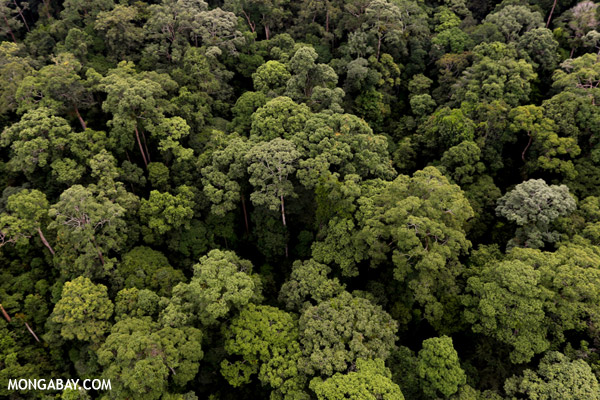
Rainforest in Borneo. Photo by Rhett A. Butler
The World Bank’s forest carbon fund got a $180 million injection from Finland, Germany and Norway, reports Point Carbon.
The bank’s Forest Carbon Partnership Facility (FCPF), which is providing funding to develop and implement Reducing Emissions from Deforestation and Degradation (REDD+) projects in three dozen tropical countries, now had $650 in its coffers. According to the World Bank, the FCPF consists of two funds:
-
The Readiness Fund (about US$260 million) currently provides grant financing to countries to develop their national strategies for reducing emissions from deforestation and forest degradation (REDD+), and put in place the systems and institutions for implementing these strategies. The Carbon Fund (US$390 million) will provide payments upon verification that emissions have been reduced from large-scale REDD+ programs undertaken in countries which have made progress in becoming ready for REDD+.
Most of the new money will go into the Carbon Fund, boosting the amount of money available to countries that reduce their deforestation rate. The bulk of the funds are coming from Norway ($100 million), followed by Germany ($74 million) and Finland ($6 million).
Experts say REDD+ will require tens of billions of dollars annually to effectively reduce tropical deforestation, which currently amounts to more than 8 million hectares per year and drives roughly ten percent of carbon emissions from human activities.

Logging in Borneo. Some critics fear that without proper safeguards, REDD+ could provide subsidies for industrial activities in tropical forests. Photo by Rhett A. Butler
The FCPF was established in 2007 but has been slow to mobilize funds for REDD+ activities. Critics note that a 2012 review by the World Bank found it cost $22 million to disburse the first $4.9 million in grants under the program.
However Hans Brattskar, Norway’s Special Envoy for International Climate Policy, said the new funds should help move the initiative forward.
“I am excited to see the Carbon Fund getting ready to pay countries and large jurisdictions for verified emission reductions,” he said in a statement. “REDD+ needs to move from planning to large scale action already in this decade if we are to maintain the two degree goal. The Carbon Fund will bring countries and companies together to create early demand for forest carbon with strong safeguards.”
Supporters of REDD+ say a well-designed mechanism could provide performance-based financial incentives for keeping forests standing while strengthening land rights and introducing reforms in the forestry sector, which in some countries is plagued with corruption and mismanagement. Critics of the concept warn that REDD+ could fail to address the underlying drivers of deforestation while exacerbating conflict over land, especially between developers and marginalized forest dependent people.
Many of the details of REDD+ are still being hammered out. For example, at present it remains unclear how REDD+ will be financed. Some argue for a market-based carbon trading approach, while others are pushing for an aid-model. The debate over the types of activities that will be allowed under REDD+ as well as safeguards to protect forest peoples’ rights and biodiversity remains intense.
Related articles